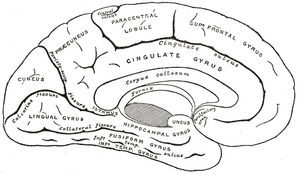
Gray's Fig. 727 - Medial surface of left cerebral hemisphere. (Fusiform gyrus visible near bottom)
The Fusiform gyrus is part of the temporal lobe. It is also known as the (discontinuous) occipitotemporal gyrus.
There is still some dispute over the functionalities of this area, but there's relative consensus on these four:
- processing of colour information
- face recognition
- word recognition
- number recognition
External links
Assessment |
Biopsychology |
Comparative |
Cognitive |
Developmental |
Language |
Individual differences |
Personality |
Philosophy |
Social |
Methods |
Statistics |
Clinical |
Educational |
Industrial |
Professional items |
World psychology |
Biological: Behavioural genetics · Evolutionary psychology · Neuroanatomy · Neurochemistry · Neuroendocrinology · Neuroscience · Psychoneuroimmunology · Physiological Psychology · Psychopharmacology (Index, Outline)
BBC lectures
In these lectures held for the BBC by neuroscientist Vilayanur S. Ramachandran as part of the REITH-lecture series, - the lecturer frequently mentions the functionality of the FUSIFORM GYRUS:
- Phantoms in the BRAIN ,
- Synapses and the Self,
- The Artful BRAIN ,
- Purple numbers and sharp cheese,
- Neuroscience the new philosophy,
| This page uses Creative Commons Licensed content from Wikipedia (view authors). |